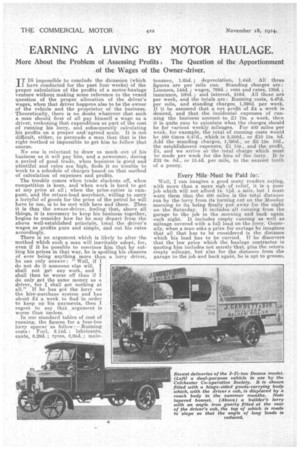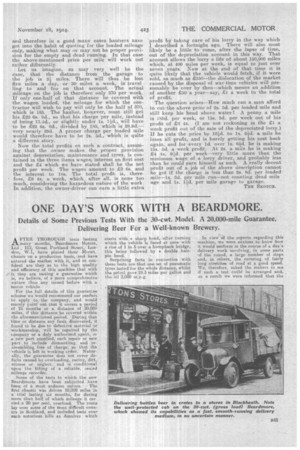EARNING A LIVING BY MOTOR HAULAGE.
Page 24

Page 25

If you've noticed an error in this article please click here to report it so we can fix it.
More About the Problem of Assessing Profits : The Question of the Apportionment of the Wages of the Owner-driver, IT TS impossible to conclude the dicussion (which I have conducted for the past four weeks) of the proper calculation of the profits of a motor-haulage venture without making some reference to the vexed question of the proper allocation of the driver's wages, when that driver happens also to be the owner of the vehicle and the proprietor of the business. Theoretically, there is no dbubt whatever that such a man should first of all pay himself a wage as a driver, reckoning that expenditure as part of the cost of running his lorry, and subsequently calculating his profits on a proper and' agreed scale. It is not difficult, either, to persuade a man that that is the right method or impossible to get him to follow that course.
No one is reluctant to draw as much out of his business as it will pay him, and a newcomer, during a period of good trade, when business is good and plentiful and rates are high, finds it no trouble to work to a schedule of charges based on that method of calculation of expenses and profits.
Tbe trouble comes when trade slackens off, when Competition is keen, and when work is hard to get at any price at all ; when the price-cutter is rampant, and the return-load merchant, willing to carry a lorryful of .goods for the price of the petrol he will have to use, is to be met with here and there. Then it is that the owner-driver, feeling that, above all things, it is necessary to keep his business together, begins to consider how far he may depart from the above well-established principle, treat the driver's wages as profits pure and simple, and cut his rates accordingly.
There is no argument which is likely to alter the method which such a man will inevitably adopt, for, even if it be possible to convince him that by cut'ting his prices in that way, be is spoiling his chances of ever being anything more than a lorry driver, be can only answer : "Well, if do not do it someone else will, I shall not ge any work, and I shall then be worse off than if do only get the same money as a driver, for I shall get nothing at all." If he has got the lorry on the hire-purchase system and has about £4 a week to find 'in order to keep up his payments, then I regret to say that argument is worse than useless.
In our standard tables of cost of running, the figures for a four-ton lorry appear as follow :--Running costs : Fuel, 2.14d. ; lubricants, cants, 0.29d. ; tyres, 0,95d. ; main
tenance, 1,65d. ; depreciation, 1.44d. All these figures are per mile run. Standing charges are: Licences, 144d. ; wages, 762d. ; rent and rates, 138d. ; insurance, 100d. ; and interest, 216d. All these are per week, and the totals are : Running costs, 6.47d. per mile, and standing charges, 1,390d. per week. If it be assumed that a net profit of £4 a week is desired, and that the incidental expenses of run
ning the business amount to 15s, a week, then it is quite easy to calculate what the charges should be for various weekly mileages. For 400 miles per week, for example, the total of running costs would be 400 times 6.47d., which is 2,588d., or 210 15s. 8d. Add the standing charges, 1,300d., or £5 15s. 10d., the establishment expenses, RI 15s., and the profit, £4, and we arrive at the total charge which must be made per week for the hire of the lorry. It is £22 6s. 6d., or 13.4d, per mile, to the nearest tenth of a penny.
Every Mile Must be Paid for.
Well, I can imagine a good many readers saying, with more than a mere sigh of relief, it is a poor job which will not afford is. 10. a mile, but I muSt warn them that the 400 miles is the total distance run by the lorry from its turning nut on the Monday morning to its being finally put away for the night • on the Saturday. It includes all running from the garage to the job in the morning and back again each night. It includes empty running as well as mileage covered with a full load on the lorry. Generally, when a man asks a price for cartage he imagines that all that has to be considered is the distance which his load has to be carried. If he discovers that the low price which the haulage contractor is quoting him includes not merely that, plus the return empty mileage, but also for the distance from the garage to the job and back again, he is apt to grouse,
and therefore in a good many cases hauliers nave got into the habit of quoting for the loaded mileage only, making what may or may not be proper provision for the empty and dead running. In that case the above-mentioned price per mile will work out rather difterently.
Let us imagine, as may very well be the case, that the distance from the garage to the job is 21 miles. There will thus be lost five miles a day, or 30 miles a week, in travel. Hug to and fro on that account. The actual mileage on the job is therefore only 370 per week. If only one-hall of that distance be covered with the wagon loaded, the mileage for which the contractor will wish to pay will only be the half of 370, which is 185. The haulier, how,ever, must still get his 222 6s. 641., so that his charge per mile, instead of being 13.4d., or slightly under is. 11d., will have • to be 222 Os. 6d., divided by 185, which is 28.9d.— very nearly 29d. A proper charge per loaded mile would therefore have to be 2s. 5d., which is quite _a different story.
Now the total profit S on such a contract, assuming that the owner makes the , proper provision against denreciation, maintenance and tyres. is contained in the three items wages, interest on first cost and the 24 which we have stated shall be the net profit per week. The wages amount to 23 Os. and the interest • to 18s. The total profit is, there. fore, 28 4s. a week, which, after all, is none too much, considering the hazardous nature of the work. In addition, the owner-driver can earn a little extra profit by taking care of his lorry in the way which I described a, fortnight ago. There will also most likely be a little to come, after the lapse of time, out of the depreciation account in this way. That account allows the lorry a life of about 150,000 miles which, at 400 miles per week, is equal to just over seven years. Now at the end of that time it is quite likely that the vehicle would fetch, if it were sold, as much as 2350—the dislocation of the market caused by the disposal of war-time vehicles Will presumably be over by then—which means an addition of another 250 a year—say, 21 a week to the total of profit.
The question arises—How much can a man afford to cut the above price of 2s. 5d. per loaded mile and still keep his head above water? A penny a mile is 155d. per week, or 158. 5d. per week out of his profit of 28 4s. (I am not reckoning in the Li a waek profit out of the sale of the depreciated lorry.) If he cuts the price by 101d. to is. 6141. a mile he loses all profit, and is barely getting his cost back again, and for every id. over is. 61d. he is making 15s. 5d. a week profit. At 28. a mile he is making 24 4s. 91d. per week—very little more than the minimum wage of a lorry driver, and probably less than he could earn himself as such. A really decent profit out of a job of the above description cannot be got if the charge is less than 2s. Gol. per loaded mile—Is. 341. per mile run—not counting dead mile age and is. 11-d. per mile garage to garage.
THE SKOTCH.
































